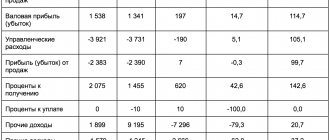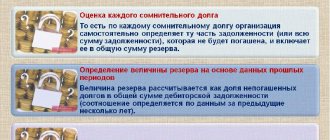Selling goods
Sales of goods are reflected in the debit of account 90 of the sub-account “Cost” (90.02.1) and the Credit of account 41, the sub-accounts of which are determined by the type of trade (wholesale/retail, etc.):
- Revenue from the sale of goods is reflected in the Credit account 90 subaccount “Revenue” in correspondence with account 62.01.
Sales of goods can be carried out through an intermediary. Then it is necessary to make entries Debit 45 Credit 41 “Goods in warehouses”. As inventory items are sold, business entries are made to the debit of account 90 “Cost” and the credit of account 45. When exporting goods, the same entries are made.
In the main taxation system, it is necessary to pay VAT on sales. The tax is reflected by posting Debit 90.03 VAT Credit 68.02.
In retail trade, goods are sold at selling price. The markup is made on account 42. When selling at the end of the month, you need to make reversing entries:
- Debit 90 “Cost” Credit 42.
Accounting: ownership has passed to the buyer
If the ownership of the product has been transferred to the buyer (i.e., a sale has occurred), income and expenses from such an operation are recorded in account 90 “Sales”. The basis for this is the primary accounting documents drawn up during the sale of products (Article 9 of the Law of December 6, 2011 No. 402-FZ).
Sales income will be revenue from the sale of finished products. Reflect it on the credit of account 90-1 at the time of transfer of ownership of the product to the buyer (subject to other conditions for recognizing revenue in accounting).
For more details, see How to determine the amount of revenue from the sale of finished products.
You can sell finished products both in cash and by bank transfer, as well as using plastic cards.
If the organization sold finished products for cash, make the following entry in accounting:
Debit 50 Credit 90-1 – revenue for finished products sold for cash is reflected.
If the organization sold finished products for cashless payment, make the following entry:
Debit 62 Credit 90-1 – revenue for finished products sold by bank transfer is reflected.
The procedure for recording sales of finished products in accounting when paying by credit card is similar to the procedure for recording such transactions when selling goods. For more information about this, see How to reflect retail sales of goods in accounting.
Such rules are established by the Instructions for the chart of accounts, subparagraph “d” of paragraph 12 of PBU 9/99 and paragraph 211 of the Methodological Instructions, approved by order of the Ministry of Finance of Russia dated December 28, 2001 No. 119n.
At the time of revenue recognition, reflect in accounting the costs associated with the production and sale of products (clause 18 of PBU 10/99). These will be:
- actual cost of production;
- selling expenses.
Reflect them in the debit of account 90-2.
This is stated in paragraphs 203, 206 and 212 of the Methodological Instructions, approved by order of the Ministry of Finance of Russia dated December 28, 2001 No. 119n, paragraphs 7 and 9 of PBU 10/99 and the Instructions for the chart of accounts.
Write off the actual cost of products sold as expenses in the order that depends on how the organization accounts for finished products: at actual cost or at standard cost.
If finished products are accounted for at actual cost, reflect them in expenses by posting:
Debit 90-2 Credit 43 – the actual cost of finished products sold is taken into account as expenses.
If finished products are accounted for at standard cost, reflect them by posting:
Debit 90-2 Credit 43 – the standard cost of finished products sold is taken into account as expenses.
This procedure follows from the Instructions for the chart of accounts.
To determine the cost of finished products that need to be written off as expenses (i.e., the cost that will be reflected in the credit of account 43), use one of the valuation methods:
- at the cost of each unit of inventory;
- FIFO;
- at average cost.
The choice of method for estimating the cost of sold finished products is fixed in the accounting policy for accounting purposes. This is stated in paragraph 16 of PBU 5/01, paragraph 73 of the Methodological Instructions, approved by order of the Ministry of Finance of Russia dated December 28, 2001 No. 119n, and letter of the Ministry of Finance of Russia dated November 16, 2004 No. 07-05-14/298.
For information on how to reflect sales expenses as expenses, see How to reflect sales expenses of finished products (works, services) in accounting.
This procedure follows from paragraphs 203–206, 212 of the Methodological Instructions, approved by Order of the Ministry of Finance of Russia dated December 28, 2001 No. 119n, Instructions for the chart of accounts (accounts 40, 43, 90).
If the organization that sells the product is a VAT payer, charge this tax at the time of its transfer to the buyer. Reflect the accrual of VAT in the debit of account 90-3:
Debit 90-3 Credit 68 subaccount “Calculations for VAT” - VAT is charged on the sale of finished products.
This procedure follows from the Instructions for the chart of accounts (accounts 68, 90) and paragraph 212 of the Methodological Instructions, approved by Order of the Ministry of Finance of Russia dated December 28, 2001 No. 119n.
If the organization has received a partial (full) prepayment on account of a future delivery, make the following entries in accounting:
Debit 51 (50) Credit 62 subaccount “Settlements for advances received” - partial (full) prepayment was received from the buyer for the upcoming delivery of finished products;
Debit 76 subaccount “Calculations for VAT on advances received” Credit 68 subaccount “Calculations for VAT” – VAT is charged on the amount of the advance received;
Debit 62 subaccount “Settlements for shipped finished products” Credit 90-1 – revenue from the sale of finished products is reflected;
Debit 90-3 Credit 68 subaccount “Calculations for VAT” - VAT is charged on sales proceeds;
Debit 62 subaccount “Settlements for advances received” Credit 62 subaccount “Settlements for shipped finished products” - prepayment is credited;
Debit 68 subaccount “Calculations for VAT” Credit 76 subaccount “Calculations for VAT from advances received” - the amount of VAT previously accrued and paid from the amount of the advance received is accepted for deduction.
This procedure is provided for in the Instructions for the chart of accounts (accounts 51, 50, 62, 90).
Finished products are usually sold in containers. For information on how to take it into account when selling products, see How to record transactions with containers when selling your own products.
Postings for the sale of goods in wholesale trade
Payment for goods can usually be made by prepayment or upon shipment of the goods.
By prepayment
Example:
The organization, after receiving an advance payment from the buyer, shipped goods in the amount of 99,500 rubles. (VAT RUB 15,178).
Postings:
| Account Dt | Kt account | Wiring Description | Transaction amount | A document base |
| 62.02 | Received money for the goods from the buyer | 99 500 | Bank statement | |
| 76.AB | 68.02 | Issuing an invoice for advance payment | 15 178 | Ref. invoice |
| 62.01 | 90.01.1 | Revenue from the sale of finished products or goods is taken into account | 99 500 | Packing list |
| 90.03 | 68.02 | VAT is charged on sales | 15 178 | Packing list |
| 90.02.1 | 41.01 | Sold goods written off | 64 000 | Packing list |
| 62.02 | 62.01 | Advance credited | 99 500 | Packing list |
| An invoice for sales has been issued | 99 500 | Invoice | ||
| 68.02 | 76.AB | Deduction of advance VAT | 15178 | Invoice |
By shipment
Example:
The organization shipped goods worth RUB 32,000 to the buyer. (VAT 4881 rub.). Payment was received after delivery.
Postings:
| Account Dt | Kt account | Wiring Description | Transaction amount | A document base |
| 62.01 | 90.01.1 | Revenue from sales of goods is reflected | 32 000 | Packing list |
| 90.03 | 68.02 | VAT is charged on sales | 4881 | Packing list |
| 90.02.1 | 41.01 | Sold goods written off | 385 | Packing list |
| An invoice for sales has been issued | 32 000 | Invoice | ||
| 62.01 | Payment received from buyer | 32 000 | Bank statement |
Accounting: ownership has not passed to the buyer
Record the shipped products on account 45 “Goods shipped”:
- at actual cost - if the organization accounts for finished products in account 43 “Finished products” at actual cost;
- at standard cost - if the products are accounted for in account 43 “Finished products” at standard cost, and the actual costs of their production are reflected in account 40 “Product Output”.
Keep accounting of shipped products on the basis of the primary accounting documents presented to the buyer (Article 9 of the Law of December 6, 2011 No. 402-FZ). When transferring (shipping) products, make the following entries:
Debit 45 Credit 43 – finished products were transferred to the buyer.
This procedure follows from the Instructions for the chart of accounts (accounts 43, 45).
To determine the cost of finished products that need to be reflected on the credit of account 43, use one of the valuation methods:
- at the cost of each unit of inventory;
- FIFO;
- at average cost.
The choice of method for estimating the cost of sold finished products is fixed in the accounting policy for accounting purposes. This is stated in paragraph 16 of PBU 5/01, paragraph 73 of the Methodological Instructions, approved by order of the Ministry of Finance of Russia dated December 28, 2001 No. 119n, and letter of the Ministry of Finance of Russia dated November 16, 2004 No. 07-05-14/298.
If the organization that ships the products is a VAT payer, at the time of shipment (transfer) of the products to the buyer, charge VAT (clause 3 of Article 38 of the Tax Code of the Russian Federation). Reflect the amount of accrued tax in accounting as follows:
Debit 76 subaccount “VAT on products, the ownership of which is transferred to the buyer in a special order” Credit 68 subaccount “Calculations for VAT” - VAT is charged, payable to the budget on shipped products, the ownership of which is transferred to the buyer in a special order.
For more information about this, see How to reflect in accounting the amount of VAT charged to the buyer when selling goods (own products), if the ownership of these goods (own products) has not transferred to the buyer.
After ownership of the shipped products passes to the buyer, record the proceeds from the sale in your accounting records. At the same moment, write off as expenses the cost of products sold and sales expenses (subparagraph “d”, paragraph 12 of PBU 9/99, paragraphs 211 and 212 of the Methodological Instructions, approved by order of the Ministry of Finance of Russia dated December 28, 2001 No. 119n, p 7 and 9 PBU 10/99).
Record sales revenue as follows.
If the organization sold finished products for cash, make the following entry in accounting:
Debit 50 Credit 90-1 – revenue for finished products sold for cash is reflected.
If the organization sold finished products for cashless payment, make the following entry:
Debit 62 Credit 90-1 – revenue for finished products sold by bank transfer is reflected.
The procedure for recording sales of finished products in accounting when paying by credit card is similar to the procedure for recording such transactions when selling goods. For more information about this, see How to reflect retail sales of goods in accounting.
Write off the cost of products sold as expenses in an order that depends on how the organization accounts for finished products: at actual cost or at standard cost.
If finished products are accounted for at actual cost, reflect them in expenses using the following entry:
Debit 90-2 Credit 45 – the actual cost of finished products sold is taken into account as expenses.
If finished products are accounted for at standard cost, reflect them in expenses using the following entry:
Debit 90-2 Credit 45 – the standard cost of finished products sold is taken into account as expenses.
This procedure follows from the Instructions for the chart of accounts.
For information on how to reflect sales expenses as expenses, see How to reflect sales expenses of finished products (works, services) in accounting.
Simultaneously with the recognition of revenue and expenses, reflect the amount of VAT charged to the buyer as expenses:
Debit 90-3 Credit 76 subaccount “VAT on products, the ownership of which is transferred to the buyer in a special manner” - VAT is charged on shipped products.
This is stated in paragraphs 203, 206 and 212 of the Methodological Instructions, approved by order of the Ministry of Finance of Russia dated December 28, 2001 No. 119n, paragraphs 7 and 9 of PBU 10/99 and the Instructions for the chart of accounts.
For more information about this, see How to reflect in accounting the amount of VAT charged to the buyer when selling goods (own products), if the ownership of these goods (own products) has not transferred to the buyer.
Finished products are usually sold in containers. For information on how to take it into account when selling products, see How to record transactions with containers when selling your own products.
Retail sales of goods
Example:
For the day, trading revenue in the store amounted to 12,335 rubles. Accounting is kept at sales prices, the organization is on the UTII taxation system, and the outlet is automated. The money was deposited at the company's cash desk on the same day.
Postings:
| Account Dt | Kt account | Wiring Description | Transaction amount | A document base |
| 50.01 | 90.01.2 | Receipt of proceeds from the sale of goods | 9000 | Cashier's report |
| 90.02.2 | 41.11 | Write-off of goods sold at sales price | 9000 | Cashier's report |
| Proceeds deposited at the cash register | 9000 | Receipt cash order | ||
| 90.02.2 | 42.01 | Calculation of markup on goods sold | -3700 | Help - calculation of markup write-off |
Postings for sales or provision of services
When selling services, the same accounts are involved, only instead of 41 accounts there are 20 accounts, which collect all the costs that make up the cost.
Example:
The organization performed services in the amount of 217,325 rubles. The cost of the service was 50,000 rubles.
Postings for the provision of services:
| Account Dt | Kt account | Wiring Description | Transaction amount | A document base |
| 62.01 | 90.01.1 | Revenue received from the sale of services | 217 325 | Certificate of completion |
| 62.01 | Receipt of payment to the bank account | 217 325 | Bank statement | |
| 90 | Cost of services provided | 50 000 | Accounting information |
simplified tax system
Regardless of which object of taxation the organization has chosen, take into account income from the sale of finished products when calculating the single tax (Articles 346.15 and 249 of the Tax Code of the Russian Federation). Income will be proceeds from sales. In the sales proceeds, also include advances received for the upcoming delivery of finished products (clause 1 of article 346.15 and clause 1 of article 249 of the Tax Code of the Russian Federation). How to calculate revenue, see On what income you need to pay a single tax under simplification.
If a simplified organization has chosen as an object of taxation income reduced by expenses, reduce sales revenue by expenses associated with the production and sale of products (clause 2 of Article 346.18 of the Tax Code of the Russian Federation). In this case, take into account only those expenses that are named in paragraph 1 of Article 346.16 of the Tax Code of the Russian Federation. Such expenses may include, in particular:
- expenses for the acquisition, construction and production of fixed assets;
- costs of acquiring or independently creating intangible assets;
- material costs, including costs for the purchase of raw materials and materials;
- labor costs;
- the amount of “input” VAT paid to suppliers, etc.
For more information on how to take into account expenses when calculating a single tax, see What expenses can be taken into account when calculating a single tax under simplification.






